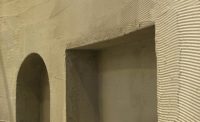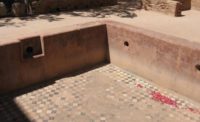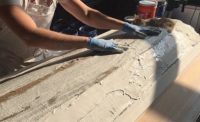Moroccan Plaster
The Art of Applying Tadelakt Plaster is a Many-Tiered Process.














In our previous article, Ryan Chivers and I considered the tradition of Tadelakt in Morocco that extends back for many centuries. For example, how its use as a practical method of sealing cisterns was expanded to other waterproofing needs such as baths and exterior plasters, eventually becoming highly appreciated as a purely decorative coating in its own right.
The application of Tadelakt is a multi-step process. The essence of skillfully applied Tadelakt is timing. Understanding when to do each step is something that is difficult to describe and requires first-hand experience. With Tadelakt, there are many ways to achieve the same result, depending on the tools and materials that are being used. This description is meant to describe the Tadelakt application as it is done traditionally in Marrakech.
Tools
The traditional tools used in Morocco are very simple. A large mason’s trowel is used for mixing. A bucket of water and large brush are used to wet the walls. The mason’s trowel is used in combination with the “Taloche,” a wood float that can be used as a hawk or a trowel to hold or apply the material. Once the material has been applied, the wood float is used to flatten and fill the surface. The mason’s trowel is then used to initially smooth the surface. The “Galet” is a hard river stone that is usually flat on one side and polished smooth. Various pieces of plastic are used for a final smoothing. One is a stiff flat piece with a polished edge. Also used is folded up sheet plastic that is used for smoothing round shapes.
Mixing
The Tadelakt is traditionally mixed very simply by hand. The material is screened through a fine screen to remove the largest pieces of aggregate. The powder is added to the water and mixed well with the mason’s trowel. The material is mixed surprisingly thin to account for the relatively high suction of traditional substrates. Pigment is added dry after the Tadelakt is mixed. The dry pigment is sprinkled with a little water then thoroughly mixed in.
Application
The first step in the application process is to test the absorption of the background. Tadelakt traditionally was applied to highly absorbent backgrounds such as thick earth, lime, or cement walls. To reduce the suction, a small amount of water is dashed onto the surface. Before large scale application, a small dab of material is applied to the wall to ensure that the background is taking up the water at the proper rate. The Tadelakt is initially applied in multiple thin layers one after another to achieve a final thickness of about 4-6 mm. The mason’s trowel is used to apply and the wood float is used as a hawk to hold the material. Alternatively, the wood float can be used as a trowel with the mason’s trowel used to scoop the plaster onto the float.
During application, care is taken to try and get a fairly even and level surface. After a short time, the wooden float is scoured over the surface to fill and flatten. High spots are ground down and low spots are filled. Another important aspect of this step is to crush in all of the bigger sand grains and to bring the fines to the surface. The next step is to smooth the surface of the Tadelakt with the mason’s trowel after the thickness of the plaster has dried until just the surface is workable. Again, a little water can be sprinkled if the surface is too dry. The plastic skimmer can also be used to smooth the surface.
After a further period of drying, the Tadelakt is ready to be polished with the stone. This process can begin when the surface is just barely movable. Polishing should continue as the surface dries until a smooth surface has been achieved. At this point, any small holes or imperfections can be filled with the trowel or the plastic skimmer and rubbed smooth with the stone. When the stone polishing is complete, and the surface has dried enough to have a slight tack, it gets burnished with the plastic skimmer. This is done horizontally, then vertically. The plastic gives the surface a high gloss and is the final step until the soap is applied the next day.
The Tadelakt is left to dry for 12 hours or more, usually overnight. The surface is thoroughly coated with soapy water and immediately polished with the stone. The surface is polished again with the stone. At this point, firm pressure is used to consolidate the surface. After the whole surface has been polished, and most of the soap has been rubbed in, a soft dry cloth can be used to wipe off any excess soap. It is common to apply several subsequent layers of soapy water with a brush in the days following the application. This step aids curing and carbonation and adds a layer of luster to the Tadelakt. It is also common to apply a coating of wax after a 30-day carbonation period.
Concluding Thoughts
A few obstacles present themselves to traditional Tadelakt application in North America. First, the materials are unique to the Marrakech region of Morocco and have a definite shelf life. Importing the materials is logistically difficult and costly. Assuring that you have fresh material that will do its job of waterproofing the surface often becomes a real challenge. Additionally, with rare exception we don’t have the same type of monolithic masonry substrates in contemporary construction to work over.
In our concluding article we’ll consider how a version of Tadelakt is being manufactured domestically and what means and methods have been developed that eases the application of Tadelakt over a variety of substrates we’re accustomed to encounter in the U.S. and Canada.
Looking for a reprint of this article?
From high-res PDFs to custom plaques, order your copy today!
















